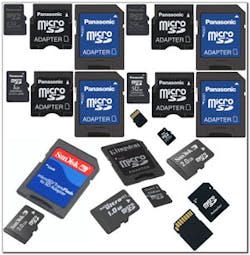Ten to 15 years ago, tape was the preferred storage medium for recorded video. At most, it held eight hours of video from a single camera at full frame rate. Then DVRs came along, which eliminated the cumbersome process of changing tapes, but you were limited to the storage capacity delivered by the manufacturer.
Only when IP-based network video hit the market did the digital revolution for video storage really begin to take off. Companies could use common off the shelf (COTS) storage systems, enabling them to incorporate rapid advancements in storage capacity and redundancy, at ever-lower costs. This was especially beneficial in video surveillance applications where archiving consumes a large amount of storage. But this is just the beginning of the storage revolution.
Exponentially Increasing Capacity
Today, you can buy 1.5 terabyte drives for as little as $129, which amounts to less than a dime per gigabyte of storage. A camera using H.264 compression and VGA resolution typically consumes 10 GB per day when storing full frame rate video, which comes to less than $2 per day in hard disk costs. That means a 1.5 TB drive could store more than 100 days of full-frame-rate video.
By contrast, the first laptop I bought in 1992 had a 25 MB drive that could only have stored one minute of full-frame-rate video if I had used H.264 compression. But back then, H.264 was not available, so I would have had to use JPEG, which meant I could have only stored 10 seconds of video on the drive. Since then, capacity has literally doubled every year, which means that compared to 20 years ago, today's regular hard drive can now store one million times more video.
More Efficient On-Board Storage Options
One of the more interesting trends in storage today are SSD, or solid state drives, which have already revolutionized the consumer electronics market. Think how fast and inexpensive memory is today for digital still and video cameras. Even laptops are starting to use SSD - also known as flash drives - to increase reliability, reduce power needs, decrease weight and improve processing speed. One day, we might very well see flash drives replace spinning magnetic discs altogether - at least in laptops.
In addition to increasing memory, the footprint of high-capacity memory card technology continues to shrink. The most common format is the SD-card (Secure Digital), which at less than two square inches, houses up to 32GB for about $50. Its small size means it can be housed inside the network camera, enabling the camera to reliably store a few days worth of full-frame-rate recordings on board.
This opens up new possibilities for maintaining physical security in locations unsuitable for housing servers to manage the video recordings. In fact, the recently released SDXC format (XC for eXtented Capacity) will eventually provide capacities up to 2TB per card, allowing months or even years of video storage inside of the camera.
More Scalable Storage Architecture
The other half of the storage revolution has been advances in storage architecture to effectively scale video surveillance systems from one to thousands of cameras. Huge storage capacities and lightning-fast data communications provide companies with endless variations in storage solutions. Three basic storage architectures can serve as the foundation for a video surveillance system:
Server-based: This is the traditional system, where a server hosts the video management application and the storage connects directly to the server. The most common server system contains two or more disks, enabling RAID redundancy in the case of a disk failure. This configuration is typically used for 10- to 100-camera systems because it easily expands into a larger system by multiplying the number of servers and connecting groups of cameras to each server. A more advanced architecture would entail connecting the server to a Storage Area Network (SAN), which would encompass an array of storage shared by multiple servers.
Network-based: Network-based storage directly connects storage devices to the network without a fully- fledged server to run the video management system and other applications. Currently there are two kinds of network-based storage: Network Attached Storage (NAS), acting as a file server on the network, and the iSCSI (Small Computer Systems Interface), which acts as a hard drive on the network - enabling a server to write data to the iSCSI device as if was a local drive. Since today's network cameras essentially operate as servers, they can store video directly to the NAS or iSCSI storage device. This gives you the option of controlling the storage via the camera or a server.
Camera-based: Camera-based storage locates storage within the camera itself. Until recently, this was fairly uncommon. But with H.264 compression drastically reducing the size of video files, along with rapid increase of SD card memory capacity, camera-based storage is now a viable option. In-camera storage is mainly used at remote sites that only record limited amounts of video, or as fail-safe back up in case the network connection goes down. Camera-based storage also allows sites to buffer the video inside of the camera during the day when network bandwidth is limited and transmit it during off-hours to a central location for archiving.
Options for Building Redundant Storage
Today's IT systems are the backbone of many organizations. Think of an airport where air traffic control and passenger check-in operate 24/7 or a bank where transactions need to be managed across global time zones within seconds. Such applications put high demands on IT systems, requiring exceptional resilience and redundant availability. There are many ways to accomplish that failover profile, depending on the level of availability required and the budget available for the project.
RAID: In their simplest form, Redundant Array of Independent Disks (RAID) mirror each other. In a RAID 1 configuration, two disks store the same information so that if one fails, the other disk still maintains the identical information. In more advanced RAID 5 schemes, multiple disks share one common redundant disk, which is a more cost-effective use of storage resources.
Hot standby server: In a hot standby server configuration, you basically have two servers storing the same data and applications. If one server goes down, the other is immediately ready to take over because it houses an exact duplicate of the primary server's information and programs.
Advances in Storage Technology
Until recently, storage was a bottleneck for video surveillance and represented a very large part of the cost - not to mention a point of contention between physical security managers and their IT counterparts. Exponential advancements in storage media and architecture, however, are rapidly changing that.
More efficient H.264 compression, along with capacity doubling on a yearly basis, and more reliable solid-state storage media are giving users more flexible, redundant and cost-effective options than ever before. We have come so far with storage technology already that it makes the days of changing video tapes every eight hours seem like ancient history. In another 15 years, today's solutions and recording times will probably seem like ancient history, too.About the Author

Fredrik Nilsson
Fredrik Nilsson is VP Americas for Axis Communications, and is the author of “Intelligent Network Video: Understanding Modern Video Surveillance Systems” published by CRC Press and now in its second edition. www.axis.com
Request more info about Axis at www.securityinfowatch.com/10212966.

